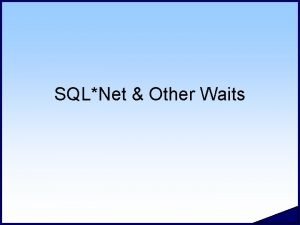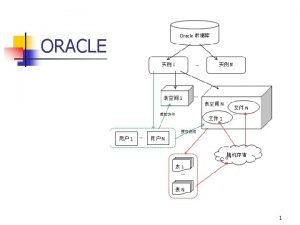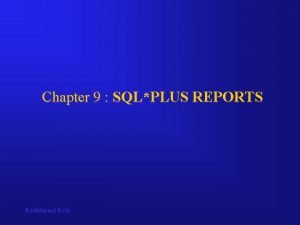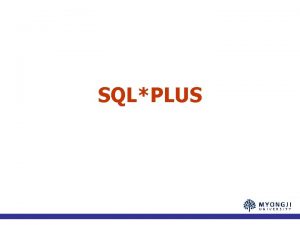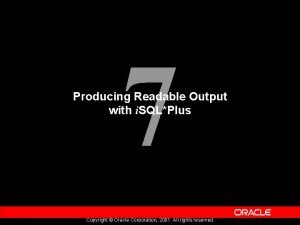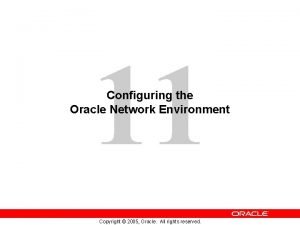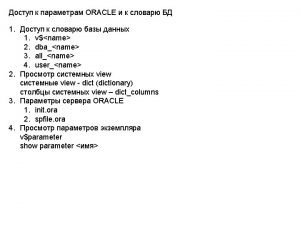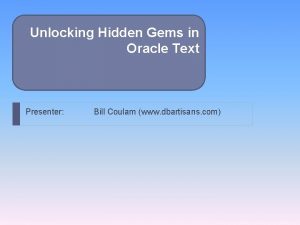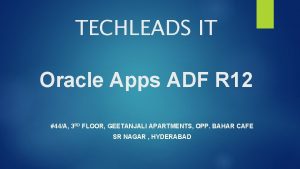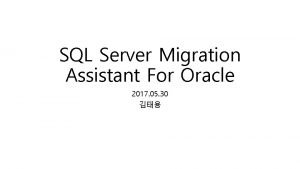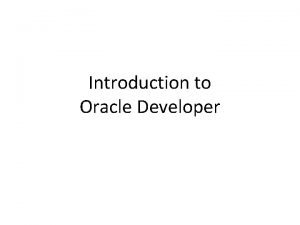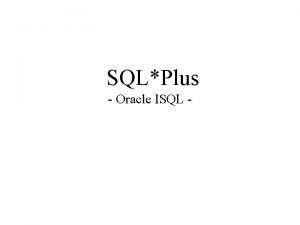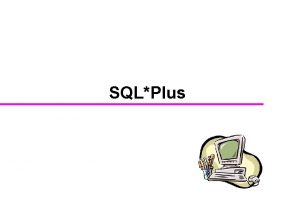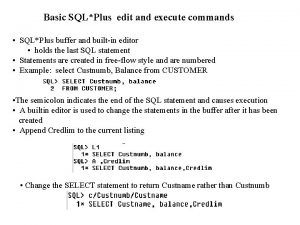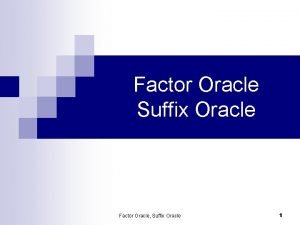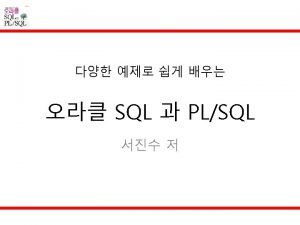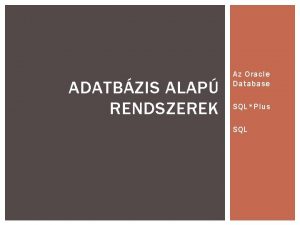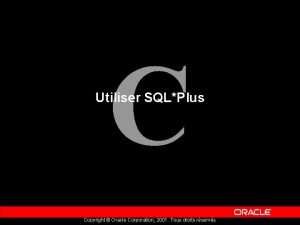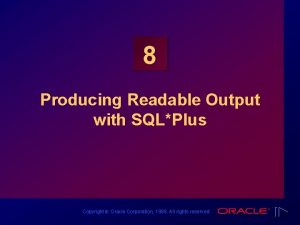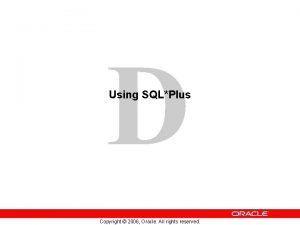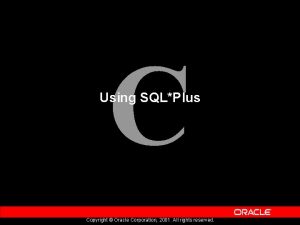ORACLE 1 SQLPlus Environment What is SQLPlus n





















- Slides: 21

ORACLE 1

SQL*Plus Environment

What is SQL*Plus? n Oracle’s development environment n n Used to write, test and debug SQL and PL/SQL code Hasn’t changed much in 20 years 3

Command Line Editor n n list or list # change n n del n n n Example: /Featuer/Feature (can use any delimiter) del (current line only) del 3 7 (range of lines) del 2 LAST (deletes from line 2 to the end of the buffer) Do NOT use the word “delete” clear buffer: clears out the SQL statement 4

Command Line Editor n append n n Places text at the end of the current line without any spaces between the existing text & the appended text input 5

Useful SQL*Plus Commands n set headsep: identifies the character that tells SQL*Plus when to split a title or column onto 2 or more lines n Default character: | n n n n Set headsep ! ttitle: sets the title at the top of each page n n n SQL> SELECT LNAME "Last_Name|Of|Employee" will display Last_Name Of Employee -------- ttitle ‘Sales by Product During 1901!Second Six Months’ If title should display an apostrophe, then use two single quotes btitle: sets the title at the bottom of each page 6

Useful SQL*Plus Commands n column: tells SQL*Plus how to handle columns n Can be used to re-label column headings n n column Item heading ‘What Was!Sold’ Can be used to specify column format n n column Item format a 18 column Rate format 90. 99 n n n Can be used to truncate data in column n n zero tells SQL*Plus to pad the number with a zero (if necessary) 999, 999 99. 90 column Item truncated (OR column Item trunc) Can be used to wrap info column Item word_wrapped 7

Useful SQL*Plus Commands n column: tells SQL*Plus how to handle columns n Can be used to specify column format n n Alphanumeric: column Item format a 18 Numeric: column Rate format 90. 99 n n Use nines and zeros to specify the numeric pattern Examples: (a) 999, 999 (b) 99. 90 n COLUMN Salary FORMAT $999, 999. 99 n See “numeric formatting” in Oracle Complete Reference 8

Useful SQL*Plus Commands n break on: tells SQL*Plus where to break for subtotals and totals n break on Item skip 2 n n n break on Item duplicate skip 2 n n n will not repeat the value in the Item column Create one line for each unique Item value and skip 2 lines will repeat the value in the Item column must be coordinated with the order by clause break on report n tells SQL*Plus to provide a grand total for the report n Example: break on Item skip 2 on report n n break on report on Item skip 2 compute sum: tells SQL*Plus to calculate subtotals n works in conjunction with the break on command 9

Useful SQL*Plus Commands n Basic rules for computing subtotals & totals: n n n Every break on must have a related order by Consecutive break on commands will override the previous break on command To create both subtotals & totals, combine the break on instructions as follows n n n break on X skip # on report OR break on report on X skip # where X = column name & # = lines to skip between sections Every compute sum must have a related break on Clear breaks and computes before setting up new ones 10

Useful SQL*Plus Commands n set linesize n n set pagesize n n sets the maximum number of characters allowed on any line; usually 70 or 80 sets the maximum number of lines per page; usually 66 lines set newpage n sets the number of blank lines between pages 11

Useful SQL*Plus Commands n spool & spool off n n Example: spool test. sql run (/) start (@) save n n saves the SQL statements, but not the SQL*Plus commands Example: save example. sql n n (or save example. sql replace) store n n saves the current SQL*Plus environment Example: store set my_settings. sql create n (or …replace or …append) 12

Useful SQL*Plus Commands n To check the current settings n n n n n column (or column_name) ttitle break compute show headsep show linesize show pagesize show newpage 13

Useful SQL*Plus Commands n To clear the current settings n n n ttitle off btitle off clear columns clear breaks clear computes 14

Useful System Tables n User_Constraints n n n User_Cons_Columns n n n Useful fields: constraint_name, table_name, constraint_type: C, P, R & U Useful fields: constraint_name, column_name, position SELECT column_name FROM user_cons_columns WHERE constraint_name=‘SYS_C 0008791’; Retrieving constraints defined by the user WHERE CONSTRAINT_NAME NOT LIKE '%SYS%'; 15

Useful System Tables n user_sequences n n Contains sequences owned by the current user_errors n n Contains compilation errors for the current user Use the ‘show errors’ SQL*Plus command to view the errors in the user_errors table 16

What Is PL/SQL? n n n PL/SQL stands for Procedural Language operating on or using SQL Combines the flexibility of SQL (4 GL) with the power and configurability of the procedural constructs of a 3 GL Extends SQL by adding 3 GL constructs such as: n n Variables and types (predefined and user defined) Control Structures (IF-THEN-ELSE, Loops) Procedures and functions Object types and methods 17

PL/SQL Constructs n PL/SQL based on Ada language constructs n n n Block Structure Error Handling Variables and Types Conditionals Looping Constructs Cursors 18

Introduction to PL / SQL

What Is PL / SQL n n n PL/SQL stands for Procedural Language operating on or using SQL Combines power and flexibility of SQL (4 GL) with procedural constructs of a 3 GL Extends SQL by adding n n Variables and types Control Structures Procedures and functions Object types and methods 20

File 3 gl_4 gl. sql Demonstrates both SQL and PL/SQL commands DECLARE v_New. Major VARCHAR 2(10) : = 'History'; v_First. Name VARCHAR 2(10) : = 'Scott'; v_Last. Name VARCHAR 2(10) : = 'Urman'; BEGIN UPDATE students SET major = v_New. Major WHERE first_name = v_First. Name AND last_name = v_Last. Name; IF SQL%NOTFOUND THEN INSERT INTO students (ID, first_name, last_name, major) VALUES (student_sequence. NEXTVAL, v_First. Name, v_Last. Name, v_New. Major); END IF; END; / 21
 Sqlplus host
Sqlplus host Set headsep
Set headsep Sqlplus report formatting
Sqlplus report formatting Pringud
Pringud Sqlplus format output
Sqlplus format output Oracle network environment configuration
Oracle network environment configuration Financial environment in business environment
Financial environment in business environment Sql developer unit testing
Sql developer unit testing Oracle preconstruction
Oracle preconstruction Oracle hana
Oracle hana Show name
Show name Oracle business partners
Oracle business partners Xmltable in oracle
Xmltable in oracle Oracle ctx
Oracle ctx Oracle telecom solutions
Oracle telecom solutions Sap oracle integration
Sap oracle integration Oracle sql tuning tutorial
Oracle sql tuning tutorial Oracle r 12
Oracle r 12 Xxxdbo
Xxxdbo Oracle developer terdiri dari
Oracle developer terdiri dari Oracle vocabulary
Oracle vocabulary What is oracle advanced security
What is oracle advanced security
